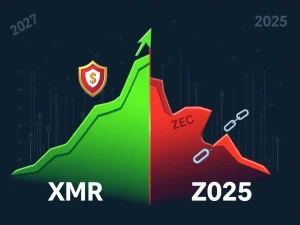Solana News Today: Asymmetric Financial’s Pivotal Shift to Blockchain Infrastructure After Dramatic Liquid Alpha Fund Decline

In the fast-paced world of cryptocurrency, market shifts can be sudden and unforgiving. Recent Solana news highlights a significant development within the crypto investment landscape, as crypto hedge fund Asymmetric Financial makes a dramatic strategic pivot. This move comes after its Liquid Alpha Fund experienced a staggering 78.37% decline, sparking public criticism and prompting a fundamental re-evaluation of its investment approach. What does this mean for the future of crypto funds, and why is Asymmetric Financial now focusing on blockchain infrastructure?
The Staggering Liquid Alpha Fund Decline: What Went Wrong?
The crypto community was abuzz when investor BigbrainSOL revealed a $10 million loss from Asymmetric Financial’s Liquid Alpha Fund on X (formerly Twitter). This substantial hit saw the fund’s portfolio plummet from $12.89 million to $2.78 million in the first half of the year, representing a 78.37% decline. Such a drastic drop naturally led to public scrutiny and concerns among limited partners (LPs).
Joe McCann, CEO of Asymmetric Financial, openly acknowledged the fund’s struggles, admitting it was no longer serving its LPs effectively. The core issues behind the Liquid Alpha Fund‘s underperformance can be attributed to several factors:
- High-Risk, Leveraged Positions: The fund previously engaged in aggressive, leveraged trading strategies, particularly in volatile crypto markets. While these can yield high returns in bullish cycles, they amplify losses during downturns.
- Controversial Strategies: McCann defended some losses as part of a ‘farm strategy’ tied to the Hyperliquid airdrop, anticipating ‘extraordinary returns’ post-airdrop. However, critics pointed to the inherent risks of such speculative, leveraged exposure.
- Solana-Related Initiative Collapse: Reports indicated that the collapse of several high-profile positions, including a controversial Solana-related initiative, significantly contributed to the fund’s decline. This underscores the volatility even within promising ecosystems.
- Market Downturn Exacerbation: The firm’s strategy of rapid trading in volatile tokens proved unsustainable when market conditions deteriorated, leading to accelerated losses and margin calls.
The experience of Asymmetric Financial is a stark reminder of the inherent fragility of leveraged crypto strategies, especially when markets are prone to sharp corrections. When prices fall, leveraged positions quickly become liabilities, triggering forced liquidations that further depress prices.
Asymmetric Financial’s Bold Pivot to Blockchain Infrastructure
In response to these challenges and the severe losses, Asymmetric Financial has announced a significant strategic pivot. The firm is moving away from liquid trading strategies and redirecting its focus towards illiquid blockchain infrastructure investments. This marks a profound shift for a firm that once thrived on high-risk, rapid trading of volatile tokens.
McCann confirmed this transition, emphasizing that the firm remains committed to blockchain innovation, stating, “Asymmetric isn’t going anywhere.” This strategic redirection involves:
- Closure of Liquid Alpha Fund: The fund will be closed, and investors will be given the option to exit their positions regardless of customary lock-up periods.
- Reinvestment Opportunities: LPs can choose to reinvest their capital into new opportunities aligned with the firm’s new focus on illiquid blockchain infrastructure.
- Focus on Durable Utility: The shift signals a preference for assets with clearer use cases and potentially less price volatility, moving towards projects with long-term utility rather than short-term trading gains.
This decision reflects a broader trend in the industry where firms are recalibrating their risk profiles. Regulatory scrutiny is increasing, and investor priorities are shifting towards more sustainable and fundamental projects within the blockchain space.
Why Are Crypto Hedge Funds Rethinking Strategy?
Asymmetric Financial is not an isolated case. Its experience highlights growing challenges in managing liquidity within crypto markets, where high leverage and concentrated positions can amplify systemic risks. Several other crypto hedge fund operations have either shuttered or significantly reduced their exposure to leveraged products following similar losses. The reasons behind this industry-wide recalibration are multifaceted:
- Market Volatility and Leverage: While leverage can magnify gains, it equally magnifies losses, making funds highly susceptible to rapid market downturns. The ‘farm strategy’ that McCann mentioned, while potentially lucrative, also carries immense risk when tied to volatile assets and future airdrops.
- Regulatory Scrutiny: Governments and financial bodies worldwide are increasing their oversight of the crypto space. This tightening regulatory environment makes high-risk, unregulated strategies less viable and more scrutinized.
- Investor Priorities: There’s a discernible shift in investor sentiment. After periods of speculative euphoria, many investors are now prioritizing projects with tangible use cases, robust technology, and long-term viability over purely speculative ventures.
- Liquidity Challenges: Managing liquidity in crypto markets, especially for illiquid or niche assets, can be complex. Large positions can be difficult to unwind quickly without significant price impact.
The pivot towards blockchain infrastructure—encompassing decentralized finance (DeFi) protocols, enterprise blockchain solutions, and core network development—signals a maturing industry. It indicates a preference for assets that are foundational to the ecosystem and less prone to the speculative swings of individual tokens.
The Future of Crypto Investment: Beyond Volatility
Asymmetric Financial’s overhaul could serve as a bellwether for how venture firms adapt to evolving market dynamics. Prioritizing sustainability over short-term gains, and investing in the underlying technology rather than just its volatile derivatives, may become the new standard. While blockchain technology continues to attract long-term capital due to its transformative potential, the sector’s ability to sustain aggressive, leveraged strategies is clearly being questioned.
Investor sentiment remains cautious, and the industry is collectively learning from past excesses. Firms that can demonstrate a clear understanding of risk, a commitment to fundamental value, and an adaptive strategy will likely be the ones to thrive in this new era of crypto investment. Asymmetric Financial’s journey from a high-flying liquid fund to a focused blockchain infrastructure investor is a compelling case study in this ongoing evolution.
Conclusion
The story of Asymmetric Financial’s Liquid Alpha Fund decline and subsequent pivot is a powerful narrative within the current crypto landscape. It underscores the inherent risks of leveraged trading in volatile markets and highlights a broader industry trend towards more sustainable, infrastructure-focused investments. Asymmetric Financial’s strategic shift to blockchain infrastructure, particularly given its past engagement with projects like Solana, signals a maturing approach to crypto investment. It’s a clear indication that for long-term success, even the most aggressive crypto hedge funds are now prioritizing foundational utility over fleeting speculative gains. This pivotal moment may well influence how other firms navigate the complexities of the digital asset space in the years to come.
Frequently Asked Questions (FAQs)
1. What caused Asymmetric Financial’s Liquid Alpha Fund to decline so sharply?
The fund’s decline was primarily due to its reliance on high-risk, leveraged trading strategies in volatile crypto markets. This included speculative positions, such as a ‘farm strategy’ tied to the Hyperliquid airdrop, and the collapse of several high-profile positions, including a Solana-related initiative, which exacerbated losses during market downturns.
2. What is Asymmetric Financial pivoting to?
Asymmetric Financial is strategically pivoting from liquid trading strategies to illiquid blockchain infrastructure investments. This includes focusing on projects like decentralized finance (DeFi) protocols and enterprise blockchain solutions that offer more durable utility and potentially less price volatility.
3. How does this pivot affect investors in the Liquid Alpha Fund?
Investors in the Liquid Alpha Fund will be allowed to exit their positions regardless of customary lock-up periods. They also have the option to reinvest their capital into new opportunities aligned with Asymmetric Financial’s new focus on blockchain infrastructure.
4. Is this a common trend among crypto hedge funds?
Yes, Asymmetric Financial’s experience reflects a broader industry trend. Many crypto funds are recalibrating their risk profiles, reducing exposure to leveraged products, and shifting towards more sustainable investments in blockchain technology due to increased regulatory scrutiny and changing investor priorities.
5. What does ‘blockchain infrastructure’ investment entail?
Blockchain infrastructure investment typically involves funding the foundational elements of the blockchain ecosystem. This can include investing in core layer-1 and layer-2 protocols, decentralized applications (dApps), developer tools, data analytics platforms, and other technologies that support the growth and utility of the blockchain space, rather than just trading volatile tokens.









